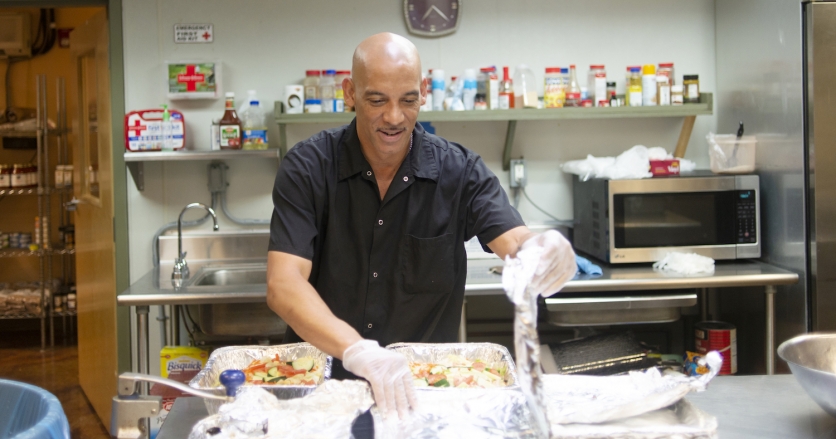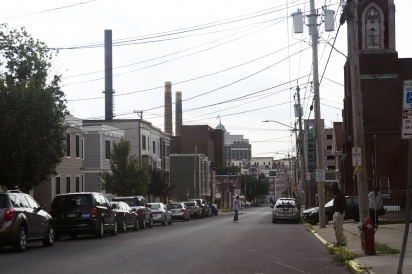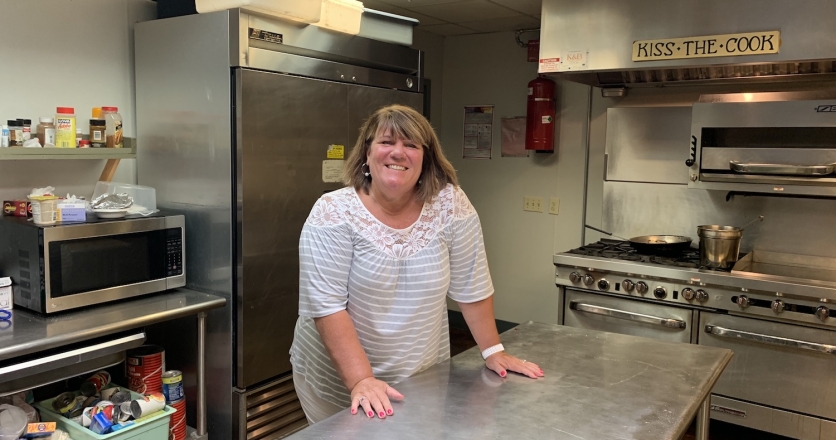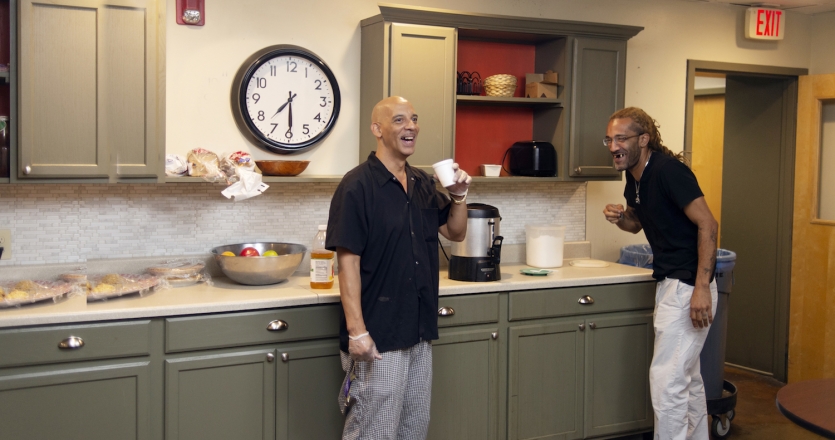IPH
On any winter night, more than 1,500 people in the Capital Region experience homelessness. Ninety-five percent are fortunate to find an emergency shelter or placement in a transitional housing program. The unlucky remainder face unsheltered homelessness, forced to spend the night in a place not meant for human habitation—a car, an unoccupied structure, an alley. Nearly a quarter of these people are children under the age of 18.*
“Being homeless and hungry is exhausting,” explains Janine Robitaille, executive director of the Capital Region’s IPH (formerly known as the Interfaith Partnership for the Homeless). “Nothing in your life is secure; you’re constantly on edge. From the moment you wake up on the street, you’re worrying about where to sleep that night. No one would choose to live this way if they had real options. People have a better chance of surviving if they can count on a meal and a clean, safe place to sleep. Our job is to take care of our guests’ basic needs. If people weren’t here, where would they be?”
When Robitaille says “here,” she means IPH’s eight programs that spread across five facilities. More than 2,000 of the region’s most vulnerable citizens are served annually through the Albany Emergency Shelter, Safe Haven, and Hoffman Family Center, located in the Sheridan Hollow neighborhood of Arbor Hill; Sister Mavis Jewell Medical Respite at St. Mary’s Hospital in Troy; and Danielle’s House in Amsterdam.
“Our approach is to look at the whole person, accept them for who they are, and then figure out what they need,” Robitaille says. “Once guests trust us, we can begin to help them in earnest. Our goal is to provide resources and support they need to become more self-sufficient and stable, such as proper food, medical attention and housing vouchers.”
Rich Grimes plays an essential role on Robitaille’s team. He’s the chef at the Albany Emergency Shelter, where he produces three squares daily for the 30 guests at the shelter. He also prepares the hot lunch that will sustain patrons at the drop-in center a few blocks up the street. Last year, more than 14,000 meals were served at the drop-in center.
“This is my dream job,” Grimes says, standing in his spotless kitchen under a “Kiss the Cook” sign. “Here, I can cook from scratch using fresh ingredients and real spices. There’s no set menu. I get along with all the guests, and I’m the first person they see in the morning. By feeding and caring for them, I actually motivate myself.”
Grimes is a graduate of Schenectady Community College’s culinary program. After 30 years of restaurant experience as a sauté cook, he decided to turn his energy to IPH. He sources most of his ingredients from the Capital Region food pantry, and Capital Roots of Troy donates dependable staples such as potatoes, carrots, onions and greens. “Price Chopper is very generous as well,” he adds.
Monday afternoons are the highlight of his week. That’s when a local church drops off boxes and crates of home-prepared, frozen food. After cleaning up from lunch, Grimes unpacks and sorts the boxes’ carefully wrapped contents. Into the capacious freezer go foil pans of mac and cheese, pulled pork, shredded chicken and baked cod. Grimes stows bags of frozen fruit salad, cut-up veggies, breakfast sausages and mashed potatoes. Pies, cakes, and muffins prepared by other groups wait on a nearby stainless-steel table.
“This is kinda like Christmas each week. I rely on these donations and try to use everything for the basis of my weekly meals. I have to be creative at times because I never know what I’ll get, but that keeps it interesting for me. When I worked in restaurants, I just pumped out food. Timelines mattered more than the quality of food. Here, I can take requests and be creative. If I know it’s someone’s birthday, I’ll make something special.”
Seventy percent of Grimes’s meals are from scratch, supplemented with donations from volunteer organizations. “Canned foods are only used as a backup in an emergency,” he states proudly. His repertoire includes stuffed chicken; steak, peppers and onions; chicken cacciatore; beef stew and chili, and hearty soups. “We offer a hot breakfast open to anyone in the community on Mondays and Fridays from 8 to 8:45am. I cook up eggs, sausage or bacon, toast and plenty of fresh coffee.
Precisely at 2:30, three guests from the drop-in center up the street arrive to transport the thermal boxes loaded with that day’s hot meal back to the center. Grimes banters easily with the young men; their mutual respect is evident. On the menu? Kielbasa, garlic sautéed potato wedges, and green beans. High fives all around.
Grimes offers a cooking class several times a month, open to guests at the emergency shelter. He would love to see this opportunity extend to patrons of the drop-in center and Safe Haven. Grimes guides his students on proper sanitation, knife skills, use of spices and herbs, and meat temperatures. He also shows them how to set a food budget and create meals out of leftovers, especially at the end of the month when money is tight. “People come to learn to cook, but they’re listening as well. I manage to slip in a little life coaching. They wear hats and aprons to show respect for the profession. Hopefully someone will advance from here and maybe find work in the food industry.”
Cyntheya, 54, is a frequent participant in the classes. She grew up in the Arbor Hill neighborhood and remembers eating fresh fruit from people’s gardens and trees. “I love cooking and always pick up some tips from Rich. Cooking has always been cathartic for me, and the kitchen is the place where I can go and leave worries and chaos behind me for a while. Th e kitchen is my zen bubble.”
IPH was founded in 1984 by a group of churches driven to find meaningful ways to address homelessness and food insecurity. The organization celebrates its 35th anniversary this year. Robitaille, who has headed the nonprofit since 2004, has seen an increase in serious mental health issues and a decline in options for safe residences.
The Albany Emergency Shelter provides temporary shelter, meals, and case management for 30 men and women. The shelter is not a drop-in facility: guests are directed there through coordinated efforts of federal, state and local agencies, and the average stay is approximately 42 days. Built in 2005, this bright, well-maintained facility is located in Sheridan Hollow, a low-income neighborhood a few blocks from the Capital.
The Hoffman Family Center, four blocks up the street in the former St. Casimir’s School and adjacent Convent, opened its doors this fall. The handsomely renovated three-story structure now houses the drop-in center, a daytime shelter that offers basic services such as lockers, laundry machines, mailboxes, clothing pantry, a hot lunch and access to case management and health care. An average of 70 guests benefit from these services each day, approximately 1,450 people a year.
Safe Haven is a nighttime shelter on Sheridan Avenue open from November to March, providing reliable emergency shelter for up to 60 people who would otherwise be forced to sleep outside. Danielle’s House in Amsterdam offers emergency, transitional and permanent housing while the Sister Mavis Jewell Medical Respite at St. Mary’s Hospital in Troy, provides short-term supportive care for homeless individuals discharged from local hospitals.
When Robitaille took over in 2004, much of Sheridan Avenue was blighted by abandoned buildings and empty parking lots. Using available funds, she started buying up the properties, strategically securing space to create housing over the ensuing years. IPH has steadily renovated and revitalized the entire block over the last decade.
“Converting these abandoned properties into affordable housing benefits the community at large,” Robitaille explains. Robitaille started A Taste of Albany in 2004, and that culinary showcase has evolved into IPH’s most significant fundraiser. Held annually in early May at the New York State Museum, A Taste of Albany features delicious creations from more than 30 Capital Region chefs, along with an array of wines, craft beers, spirits and ciders. This extraordinary event brought in more than $165,000 in May 2019.
In late 2018, IPH completed a $5.8 million Campaign for Community Connections, which helped fund the St. Casimir’s renovation. According to Robitaille, “This spacious new home now allows for improved services and numerous collaborations with community partners that complement the work we do.” IPH received the Albany Business Review’s “Best Place to Work” award in 2018. That same year, Robitaille received the Excellence in Management award by the Capital Region Chamber of Commerce Women of Excellence.
What keeps Robitaille motivated in the face of mounting pressures on the system and programs? “I feel a drive to be here and care for these people. Our job is to fi nd shelter for these people, help them access food stamps, health care and other forms of humanitarian support. We can cut through a lot of red tape and focus on getting our guests the help they need.”
So how can volunteers get involved? Kara Gargiulo, community outreach coordinator, works closely with Rich Grimes and orchestrates groups who wish to donate supplies and prepare meals. Restaurants, schools, religious organizations, businesses, families and teams of friends secure a date and prepare meals that will serve 30 to 60-plus guests. “In 2018, volunteer groups provided more than 12,000 meals for guests,” she says. “Those donated meals reduce pressure on an already tight budget.”
“Organizing supply drives for pantry staples, laundry detergent, and clothing is a great way to help educate about the importance of caring for our vulnerable neighbors,” adds Erin Coufal, director of marketing and communications. “People can rally around food: they can donate money or make and serve meals. Winter is tough at shelters. When the weather turns extreme, that’s when our guests need us most.”
Thanks to the coordinated eff orts of IPH’s staff and a squadron of volunteers, several thousand of our vulnerable citizens can sleep safely and be sustained by nutritious meals in the challenging months ahead.
*State of Homelessness of Capital Region Report 2017
Interfaith Partnership for the Homeless
Schenectady Community College
Capital Region food pantry
Capital Roots of Troy











